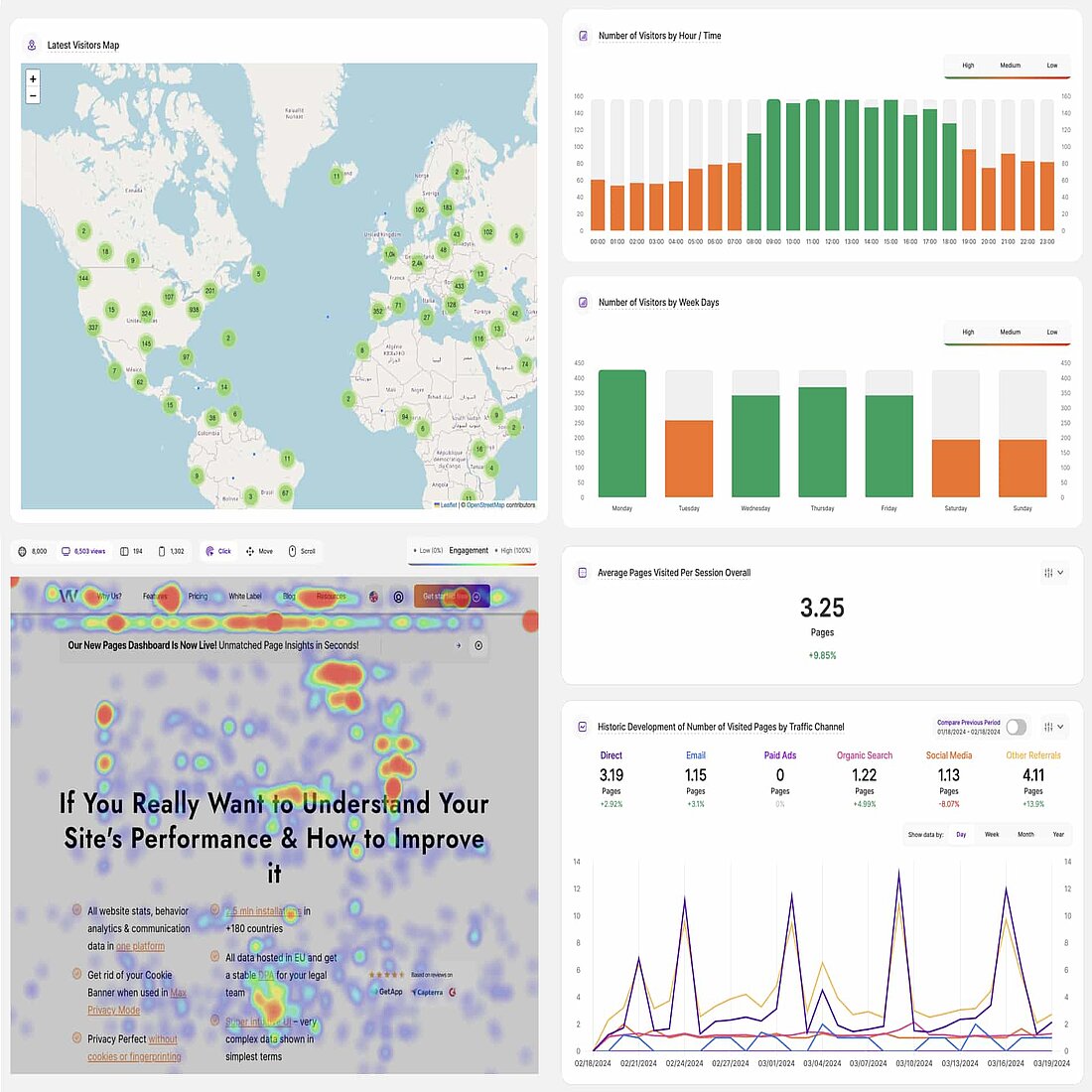Enterprise Analytics: Boosting Digital Data Efficiency for Big Businesses

Simon Coulthard March 19, 2024
- Enterprise Analytics Definition
- Benefits of Enterprise Analytics
- How Are Businesses Using Enterprise Analytics
- Creating an Enterprise Analytics Strategy
- What Is an Enterprise Analytics Platform
- What To Consider When Choosing An Enterprise Analytics Tool
- Top Enterprise Analytics Software
- 1. TWIPLA
- 2. Google Analytics 360
- 3. Microsoft Power BI
- 4. SAS Enterprise Miner
- 5. Tableau

Enterprise data analytics is particularly vital for big businesses - the top 1% for size according to European Commission data, with high data volumes and complex data analytics requirements.
It’s a fertile avenue to explore. In this quality, enterprise data and analytics of it can help to maximize profits, streamline workflows, and sustain long-term market dominance. And at this scale, even minute calibrations to data can have a big impact on performance.
This blog will explain how in the context of digital data. It’ll leave out the finance and other business indicators that others consider part of the term, and which fall outside of our scope of expertise.
So read on to understand the benefits of enterprises taking a holistic approach to data analytics, and learn about some of the best analytics platforms for this goal.
Get Monthly Website Intelligence Insights
Keep pace with the fast-moving world of privacy-first analytics. Subscribe to our newsletter and get monthly TWIPLA updates alongside digital optimization intelligence, direct to your inbox.
Enterprise Analytics Definition
Enterprise data analytics refers to the process of collecting, organizing, and interpreting the vast amount of data available to large organizations. This analytics then guides decision-making across all the various departmental and operational aspects of the business.
When done well, digital data from across the enterprise’s digital environment is pulled into one place for analysis. This removes restrictive data silos from different software and data sources, and best enables the business to extract meaningful patterns, trends, and correlations from it.
Of course, nothing is ever simple at this scale. Enterprise big data analytics often demands some interdepartmental strategic realignment, particularly if the business’s end objectives are not fully in sync with marketing - something that’s all too common with larger businesses that juggle competing goals.
Benefits of Enterprise Analytics
Adopting the right enterprise analytics tools and empowering them with the right internal processes can have the following advantages:
- Data-Driven Decision-Making: This is enhanced by the data relationship possibilities when everything is analyzed in one platform, and without the siloing created when data is spread between software platforms.
- Operational Efficiency: More data makes it easier to identify inefficiencies, streamline processes, and optimize resource allocation.
- Customer/Client Experience: Analytics that has data from different sources and channels will reveal more about customer preferences and business opportunities.
- Competitive Advantage: Data means money and big businesses can turn better data utility into market differentiation while also benchmarking performance.
Choose All-in-One Analytics
TWIPLA's a privacy-perfect choice for enterprises wanting to centralize data management and bring their web intelligence tools under one umbrella. We offer customizable plans and are happy to build new tools to optimize analytics utility.

How Are Businesses Using Enterprise Analytics
Large businesses are leveraging enterprise analytics in the following ways:
Enterprise Data Analytics
Enterprise data analytics involves the analysis of large datasets from various sources within an organization, such as customer data, sales figures and operational metrics.
What matters here is pulling these different data points together to pinpoint otherwise hidden data synergies. These could be insights into market trends, customer behavior, and operational performance, and enable better decision-making and granular readjustments.
Enterprise SEO Analytics
Enterprise SEO analytics focuses on analyzing search engine optimization data to improve visibility on these crucial online hubs. Increasing rankings involves tracking keyword performance, monitoring website traffic and engagement metrics, and optimizing content and website structure to drive targeted traffic.
Enterprises should expect maximum visibility from organic search given their size and stature, but it’s highly competitive at the top and responding to this means being able to analyze all SEO data in one place.

Enterprise Web Analytics
Enterprise web analytics refers to platforms like Google Analytics that analyze website traffic and user engagement to provide insights on visitor behavior, preferences, and demographics
By tracking metrics such as page views, bounce rates, and conversion rates, enterprises can optimize website performance, enhance user experience, and achieve their online objectives effectively.
However, enterprise web analytics can be challenging for big businesses due to the scale and complexity of their digital ecosystems. These can encompass numerous websites, platforms, and channels and this makes the holistic analysis cumbersome.
Enterprise Marketing Analytics
Enterprise marketing analytics encompasses the analysis of marketing data from various channels and campaigns. It acts as a hub to digital outreach to measure the effectiveness of marketing efforts, allocate resources efficiently, and maximize return on investment (ROI). This includes analyzing metrics such as customer acquisition cost, conversion rates, and campaign attribution to optimize marketing strategies and drive business growth.
This can be a challenge for big businesses, with the sheer volume and diversity of data generated across multiple channels, campaigns, product lines, and global regions. Managing this vast amount of data requires robust infrastructure and sophisticated tools for data collection, integration, and analysis, which can be complex and resource-intensive to implement.
Furthermore, big businesses may face organizational barriers such as data silos, lack of alignment between departments, and differing priorities, making it difficult to achieve a unified view of marketing performance and effectively leverage insights for strategic decision-making. Additionally, ensuring data accuracy, privacy compliance, and security within large-scale marketing operations adds another layer of complexity to enterprise marketing analytics for big businesses.

Creating an Enterprise Analytics Strategy
An enterprise analytics strategy will balance the four aspects introduced in the previous section. Creating an effective one involves:
- Defining Objectives: Clearly outline the goals and objectives of the analytics initiative, aligning them with the organization's overall business strategy.
- Data Collection and Integration: Identify relevant data sources and ensure proper collection, integration, and quality assurance to ensure data accuracy and completeness.
- Analysis and Insights Generation: Utilize advanced analytics techniques and tools to analyze data, extract meaningful insights, and derive actionable recommendations.
- Implementation and Monitoring: Implement analytics-driven initiatives and solutions, continuously monitor performance metrics, and iterate strategies based on insights and feedback.
Of course, nothing is ever easy at this scale. Large data projects can be tricky to turn from boardroom discussion into effective workflows. Thankfully, this can be facilitated by the right enterprise analytics platform.
What Is an Enterprise Analytics Platform
Today, enterprise analytics platforms exist to handle all four analytics aspects holistically. These solutions are designed to facilitate the collection, analysis, visualization, and interpretation of data within an organization.
Alongside advanced analytics capabilities, they have data management tools and visualization features to harness the power of data and drive informed decision-making across all levels of the organization.
What To Consider When Choosing An Enterprise Analytics Tool
When selecting an Enterprise Analytics Tool, consider factors such as:
- Scalability: Ensure that the tool can handle large volumes of data and scale with the growing needs of your organization.
- Integration Capabilities: Choose a tool that seamlessly integrates with existing systems and data sources to facilitate data sharing and analysis.
- Ease of Use: Look for an intuitive interface and user-friendly features that enable users to access, analyze, and visualize data with minimal training.
- Advanced Analytics Capabilities: Evaluate the tool's analytical capabilities, such as predictive modeling, machine learning, and data visualization, to ensure it meets your organization's analytical requirements.
Top Enterprise Analytics Software
Some of the best enterprise analytics solutions include:
1. TWIPLA
TWIPLA is a privacy-first web intelligence solution that enterprises can use to guide strategies. Our platform provides complete statistics on site-and-channel performance, as well as visitor behavior analytics tools and visitor communication options.
TWIPLA's holistic approach to analytics can help large businesses to centralize their data and pull out more subtle synergies than they would using multiple tools simultaneously. Privacy-first technology means enterprises can also leverage insights without needing to establish additional legal compliance processes. This makes TWIPLA an excellent a strong cost-saving tool, and one that provides businesses with a larger dataset to work from than what's available elsewhere.
2. Google Analytics 360
Google Analytics 360 is Google’s premium-level web statistics platform, with a range of additional features for enterprise clients. These include enhanced data processing, integration with Google BigQuery, and also advanced segmentation options.
It’s a good choice for enterprises already plugged into Google’s wider infrastructure and offers the usage-based pricing structure that is ideal for scalability. Google Analytics 360 does need technical expertise to operate, but there’s no shortage of add-ons to grow functionality in the right direction.
3. Microsoft Power BI
Microsoft Power BI is an advanced business intelligence suite. It offers a wide collection of different software services, applications, and connectors that enterprise users can call on to analyze, visualize, and share data on a massive scale.
It’s highly customizable, supports all data sources, and machine learning provides useful predictive analytics. Microsoft Power BI has a steep learning curve and compatibility issues for Mac users and others, but it’s got the capacity to handle any data requirements.
4. SAS Enterprise Miner
SAS Enterprise Miner is an advanced data mining and predictive analytics platform that enables organizations of any size to build and deploy predictive models to solve complex business problems and drive decision-making processes forward.
Once the data is fed in, this platform will generate actionable insights through an intuitive interface that can be used to detect fraud, anticipate resource demands, minimize customer attribution, and so on. It's a great option, and particularly for users without previous mining experience or programming knowledge.
5. Tableau
Tableau is an enterprise IT solution that analyzes data any number of sources. It makes clever use of BI so that non-analysts or IT professionals can pull actionable insights from complex data, and this is why they call themselves a self-service solution.
Tableau aims to help people see and understand their data. They have designed their product to simplify data analysis so that it’s not restricted to expert analysts and IT professionals.
Tableau can be used by hundreds of enterprise staff simultaneously, though this utility comes at a heavy cost to privacy if data is not governed properly in-house. Subscription price is based on user number, making it simple for enterprises to tailor plans to their needs.
Custom Pricing for Enterprises
TWIPLA's pricing is built around traffic volume, making it easy to choose the right enterprise package that scales with your needs. Trial the full enterprise package for 30 days, or open a free account and assess utility within a test environment.
That’s Enterprise Analytics Explained
Everything tends to be more difficult for large enterprises. Analytics is no different, particularly when done well. The analytics enterprises do means more data sources, more complex decision-making processes, and more interdepartmental friction.
That said, technology remains a powerful driver for change. TWIPLA is a strong choice that enables enterprises to do all their analytics in one platform, reducing data silos while also building a foundation for better governance.
Pricing plans are also completely customisable for enterprises, and we’re happy to develop features to enterprise specification. Feel free to book a platform demo to find out more.
Share article
Get Started for Free
Gain World-Class Insights & Offer Innovative Privacy & Security


Stay Updated & Get Inbox Insights
Keep pace with the world of privacy-first analytics with a monthly round-up of news, advices and updates!











